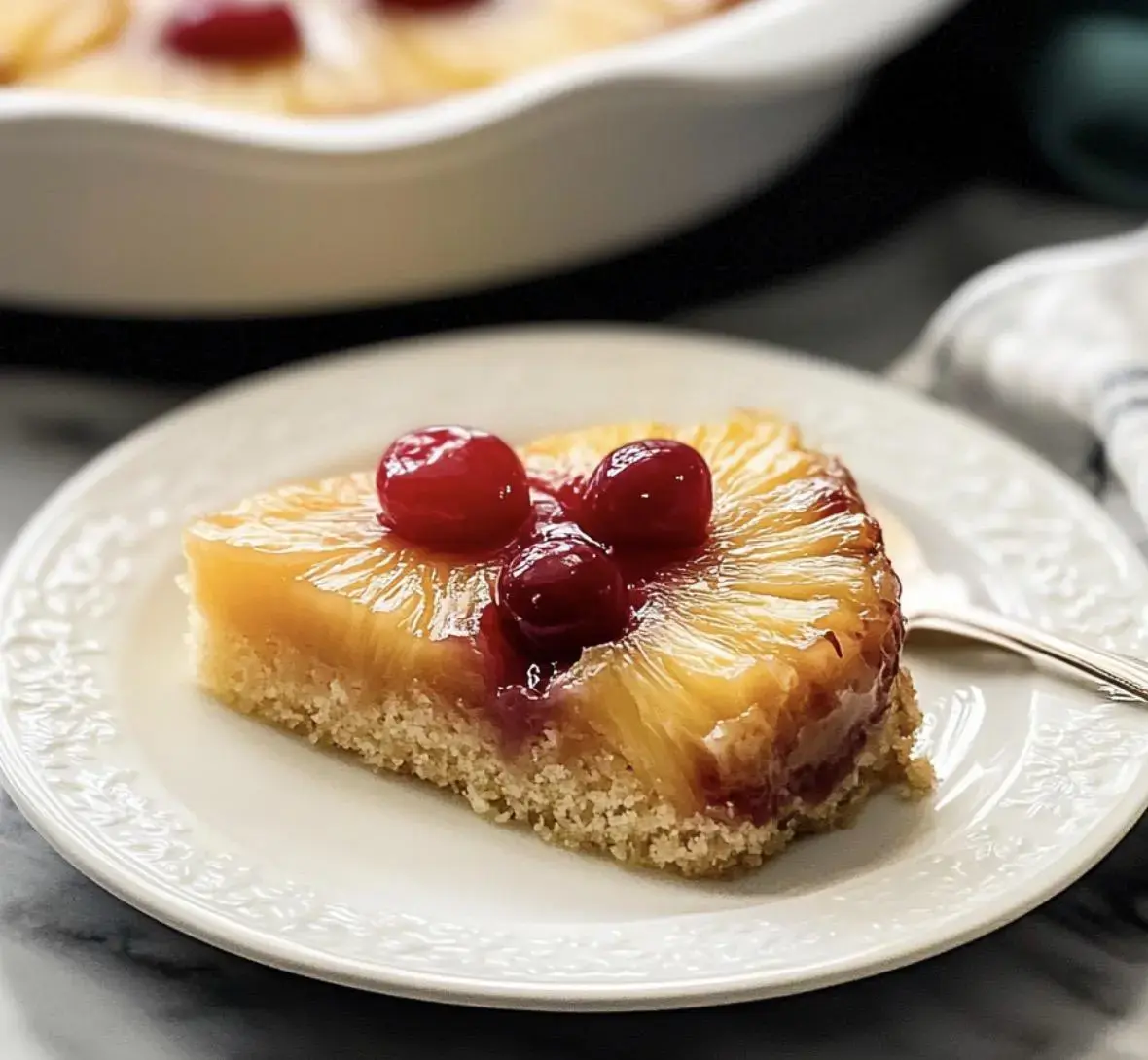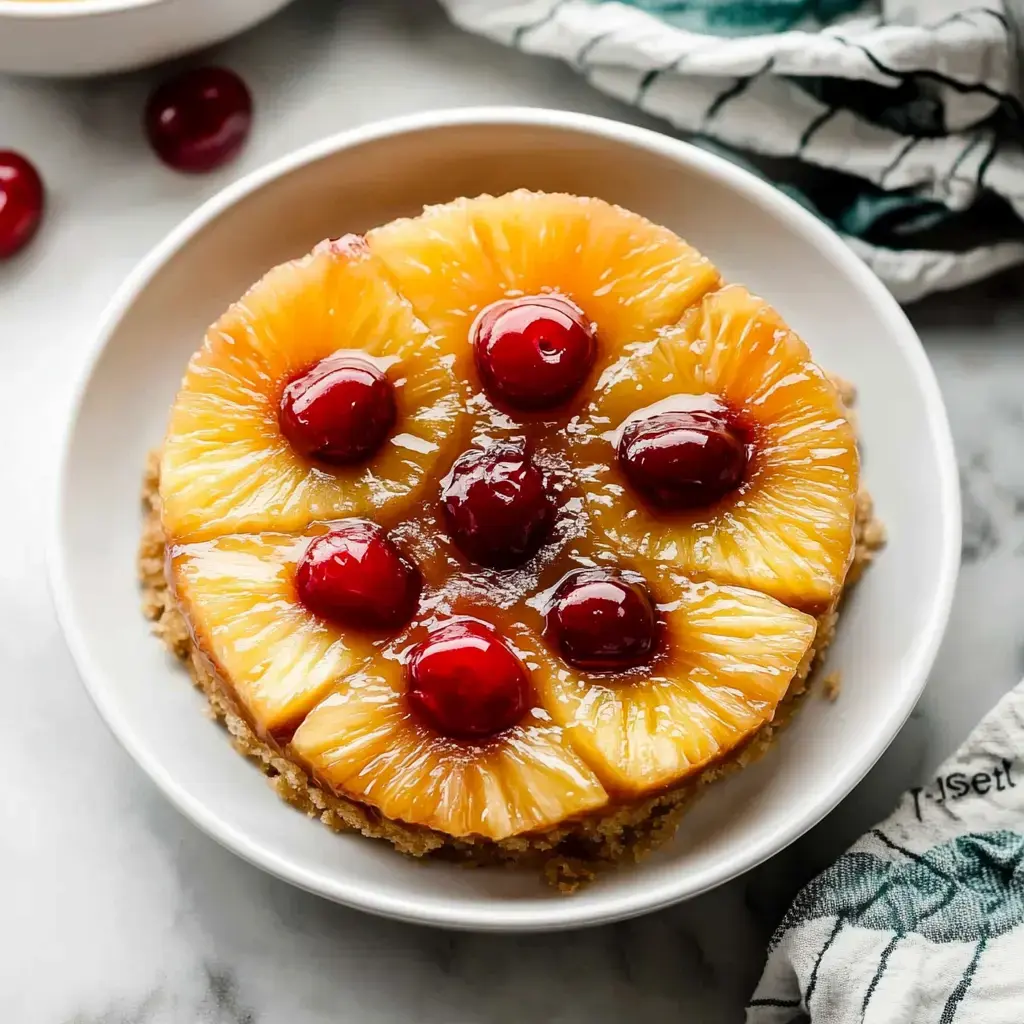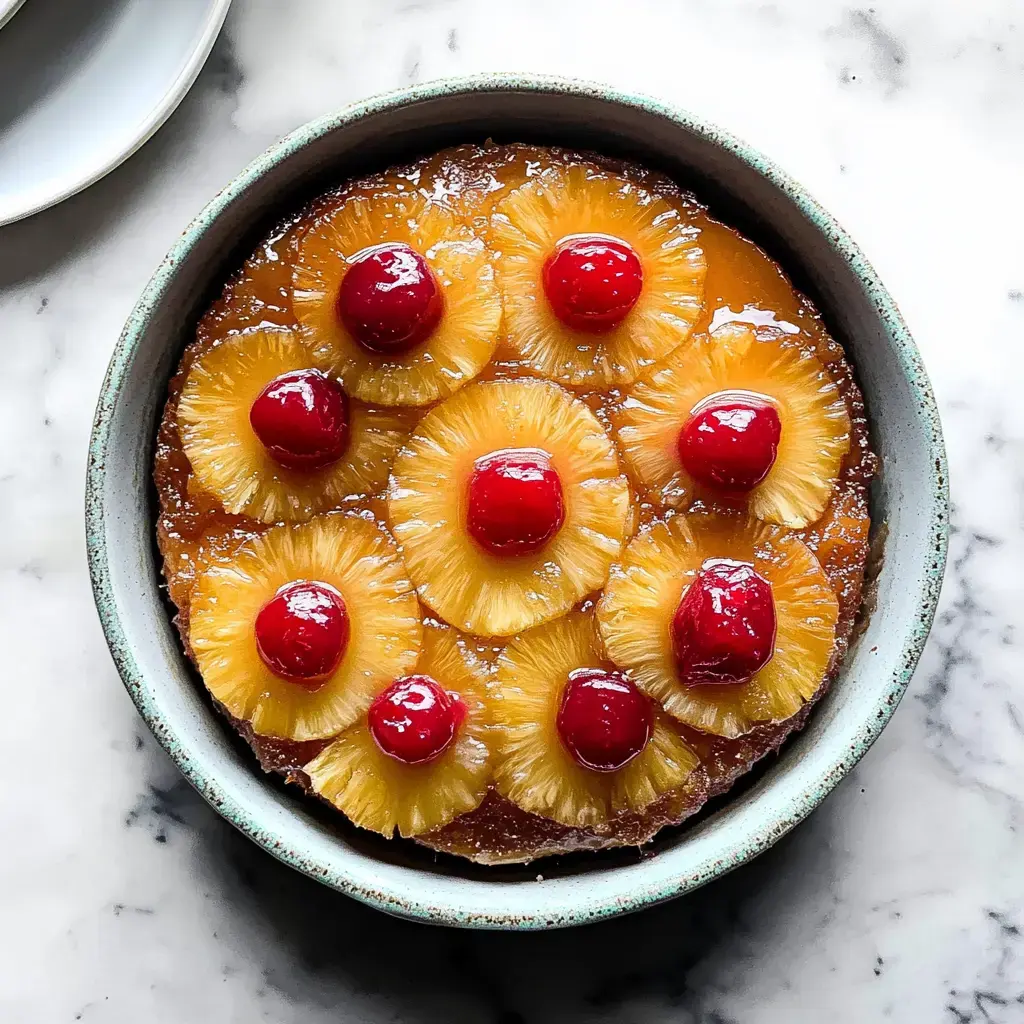 Pin it
Pin it
Craving that tropical dessert classic? Every mouthful of this treat brings back childhood memories. Our no-fuss pineapple cake turns out soft and buttery underneath rings of sweet, caramelized fruit and bright cherries. It works brilliantly whether you're making it from scratch or speeding things up with a box mix.
What Makes This Cake Special
This tropical dessert uses clever techniques for amazing results. We've picked cake flour and whipped egg whites for extra softness, while the fruit creates its own gorgeous glaze as it bakes. Don't bother with those silly cocktail versions - the real thing hits your sweet spot way better! It's so simple to make but completely satisfies your dessert cravings.
Key Components
- Butter (Melted): Forms the sweet base
- Sugar (Brown): Transforms into gooey caramel
- Rings of Pineapple: The star of the show
- Bright Cherries: Adds pops of color
- Special Flour: Ensures tenderness
- Powder for Baking: Gives the lift
- Soda for Baking: Creates fluffiness
- Pinch of Salt: Cuts the sweetness
- Room Temp Butter: For the batter
- White Sugar: Sweetens everything
- Whites of Eggs: Makes it airy
- Cream (Sour): Adds moisture
- Touch of Vanilla: Boosts flavor
- Juice from Pineapple: Enhances fruitiness
- Splash of Milk: Softens the texture
 Pin it
Pin it
Detailed Instructions
- Mix Your Base:
- Combine flour, sugar, salt and yeast in a large bowl. Take your butter straight from the fridge, chop it small, and rub it in until you see something like coarse sand. Don't rush - getting this right creates those wonderful layers.
- Work The Dough:
- Add cold milk and stir until it forms a ball. Dump it onto your counter and push it around for about 10 minutes till it feels smooth. You want it silky but not sticky. Just add a tiny sprinkle of flour if it sticks to your hands.
- Initial Shaping:
- Flatten your dough into a rough rectangle shape. Nothing fancy needed yet. Wrap it up tight in plastic and press it down. This helps later when we fold it.
- Chill Time:
- Stick it in the fridge for at least 2 hours. This pause matters - it lets the butter harden up and gives the flour time to absorb moisture. Leaving it overnight works too.
- Butter Block Prep:
- While waiting, take cold butter and bash it between wax paper into a 5x8 inch rectangle. Keep the edges straight and even - that's what makes those gorgeous flaky bits. Pop it back in the fridge if it starts to soften.
- First Fold:
- Roll your cold dough twice the size of your butter block. Put the cold butter in the center and fold the dough over it like you're sealing an envelope. Pinch all edges shut to trap the butter inside.
- Building Layers:
- Roll this packet into a long rectangle, trying to keep straight sides. Fold it like a business letter - bottom third up, top third down. Wrap it up and chill for 30 minutes. You'll repeat this step three more times.
- Overnight Pause:
- After your final fold, wrap your dough snugly and leave it in the fridge overnight. This long rest isn't just convenient - it makes the dough easier to handle and tastes better too.
- Cutting Shapes:
- Next day, roll the dough about 1/4 inch thick. Cut triangles for traditional shapes, or squares if you're adding chocolate. Make clean, decisive cuts for best results.
- Proofing Stage:
- Put your shaped dough on baking sheets. Let them sit at room temp until they look puffy - around 2 hours. They should feel light and bouncy, jiggling slightly when you nudge the pan.
- Oven Prep:
- Heat your oven to 400°F. Mix an egg with a splash of milk and gently paint this all over your pastries, including the sides. This gives them that mouthwatering golden finish.
- Final Bake:
- Put them in the oven for 20-25 minutes until they're deeply golden. They should look rich and smell heavenly. Let them cool a bit before biting in - the inside gets super hot!
Ingredient Breakdown
The stuff you put in your cake really counts. That special baking flour (or a decent box mix for a quicker version) gives it an extra-soft texture. Adding egg whites and sour cream works wonders too. All these bits team up to create something light and fluffy that still holds up all that juicy fruit on top.
Nailing The Fruit Layer
What makes this cake truly stand out is that amazing fruit layer. Dry your pineapple rings with paper towels first, then arrange them with cherries over a bed of butter and brown sugar. This creates that iconic look everyone loves. Whether you're cooking from scratch or using a shortcut with premixed batter, this topping turns gloriously sticky-sweet during baking.
Foolproof Baking
Getting your cake just right takes proper oven time. Because of all that fruit on top, it needs to bake longer than your average cake. Put a cookie sheet underneath to catch any drips, and cool it a bit before you flip it over. Follow these simple tips and your cake will turn out perfectly every single time.
How It Feels And Tastes
This isn't your everyday fluffy cake. It's got a slightly heavier feel thanks to all that fruit, but that's exactly what makes it so good. Every forkful gives you soft cake underneath and sweet, caramel-coated fruit on top. The contrast between the two is what keeps everyone coming back for seconds.
 Pin it
Pin it
Ways To Enjoy It
This treat fits any occasion you can think of. The fruit pattern on top means it's naturally pretty without any extra fuss. You can enjoy it slightly warm or at room temp - both are fantastic. Try adding a dollop of whipped cream or a scoop of vanilla ice cream to take it up another level. It'll beat those novelty shots at parties any day!
Frequently Asked Questions
- → Can use can fruit?
Totally fine with canned fruit. Just dry the rings completely. Maybe keep some juice handy. Fresh works great too. You just need good slices.
- → Sugar not browning?
Make sure butter covers everything. Sprinkle sugar all over. Let it melt completely first. Be careful with temperature. Don't mix it around.
- → No sour cream?
Try Greek yogurt instead. Regular yogurt works too. Maybe buttermilk. You need something with tang. It keeps everything moist.
- → Keeping leftovers?
Store it in an airtight container. Keep in the fridge. Won't last beyond three days. Warm it up a bit. The flavor stays nice.
- → Need foil cover?
It stops the top from burning. Don't make it too tight. Just place it loosely. Peek underneath occasionally. Might need it earlier than you think.
- → Getting too brown?
Put foil on top loosely. Turn down the temperature. Move the pan lower. Start checking sooner. Watch the sides carefully.
- → Taking it places?
Transport it flat. Use a container with tall sides. Bring a serving dish along. Maybe flip it there. Avoid bumpy roads.
- → Need it quick?
Go with a boxed cake mix. Get fruit ready beforehand. The flip trick still works. One-pan cooking is fast. Looks impressive anyway.
- → Making big batch?
Doubling works well. Just grab a larger pan. It might need extra time. Check the center carefully. Good oven circulation matters.
- → Want more flavor?
Throw in some spices. A splash of rum works wonders. More vanilla is always good. Even add some nuts. But don't cover up the fruit.
- → Cake not flipping?
Wait a bit longer. Slide a knife around the edges. Turn it over fast while hot. Use a flat enough plate. Two hands make it easier.
- → Fruit stuck in pan?
Put the pan back on. Gently scrape it off. Place it on top of the cake. It'll still look good. Use more butter next time.
Conclusion
Enjoyed this? Go for fruit tarts next time. Or maybe try a chilled fruit and cream cake. Both showcase beautiful fruit toppings.
